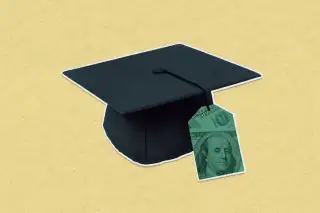Millions of Borrowers Behind on Student Loan Payments Just Got a 'Fresh Start'

Millions of people who have fallen behind on their student loan payments just got some very welcome news.
In addition to extending the student loan pause — in place since spring 2020 — through Aug. 31, the U.S. Department of Education announced Wednesday that it's pulling borrowers who were in default pre-pandemic out of default. They will receive a "fresh start" on repayment by "eliminating the impact of delinquency and default and allowing them to reenter repayment in good standing," the department said in a statement.
Borrowers fall into default after missing nine monthly payments, after which they lose access to certain repayment plans and their accounts are sent to collections.
Before the pandemic, about 20% of all federal loan borrowers were in default. The fresh start will apply to all federal borrowers in default, including those with direct loans, as well as older loans from the Federal Family Education Loan program.
The department's decision to pull borrowers out of default is an important step toward fixing a broken student loan system, Abby Shafroth, interim director of the National Consumer Law Center's Student Loan Borrower Assistance Project, said in a written statement. It will ensure that when the pause ends, borrowers and their families won't be set back by default collection practices, she added.
The move matters because the consequences of default are draconian for borrowers, as Persis Yu, policy director and managing counsel at the Student Borrower Protection Center, previously told Money. The government can seize borrowers' wages, Social Security benefits and tax refunds and credits without going to court.
And because there's no statute of limitations on collections during the borrower's lifetime, they can do it forever. A default can also have long-lasting impacts on a person's finances; for example, it can hurt their credit score.
Around 90% of the 7.7 million borrowers with federally held loans who were in default when the pandemic started are still in default, according to data from the Education Department. While a little-known provision in the Coronavirus Aid, Relief, and Economic Security Act (CARES) Act passed in March 2020 could have helped many borrowers exit default completely, few knew about it.
As a result, advocates have been calling on the Biden administration to automatically pull defaulted borrowers out of default throughout the pandemic. They argued that asking borrowers who are already in a strenuous financial situations to manage the paperwork-intensive process themselves wasn't working. It appears the administration listened.
Yu applauded the Biden administration's move Wednesday but joined the growing chorus of voices urging the president to take it a step further and forgive student debt entirely.
"The Department must not squander this opportunity to fix the broken student loan system," Yu said in a statement. "Under this new swift deadline, the Department must work fast to end its punitive collection practices, ensure meaningful pathways for borrowers to get out of debt, and provide widespread debt cancellation."
More from Money:
Student Loan Pause Extension: Biden Confirms Payments Won't Resume Until September
How to Refinance Student Loans
How 2 Years Without Student Loan Bills Changed the Game for America's Borrowers